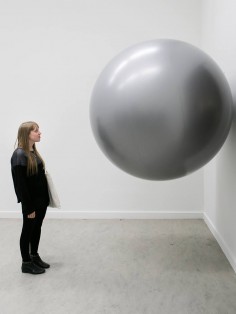EDITH DEKYNDT
Major Tom
source: z33be
De projecten van de Belgische Edith Dekyndt focussen op de ruimte, het ervaren van de betekenis en inhoud hiervan en de bijzonderheden van de ruimte zelf. Ze is gefascineerd door efemere en ongrijpbare fenomenen. Ze gebruikt vaak materialen en middelen uit het dagelijkse leven (muziek, papier, neons, teksten,…) om erg poëtisch objecten, performances of installaties te creëren. Edith Dekyndts werk verkent de limieten van de relatie tussen kunst, wetenschap en zoekt de grenzen op van onze fysieke werkelijkheid.
.
.
.
.
.
.
.
.
.
source: z33be
The projects of Belgian artist Edith Dekyndt are focused on the occupation of space, experiencing its meaning and contents, the particularities of space itself. Using images, texts, videos, and simple technical solutions the artist raises questions relating to both the individual and global positions of people in society. Whatever the form is, the work is completed with modest tools arising from everyday life (music, paper, neons, texts, threads…).
Edith Dekyndt’s work explores the limits of the relationship between art, science and reality.
.
.
.
.
.
.
.
source: ecoledumagasin
Edith Dekyndt was born in Belgium in 1960. Using various formats, she presents material that has been subjected to the irreversible action of time and the sometimes ephemeral transformations that result from it. The observation at a distance of unobtrusive physical phenomena constitutes the main object of her research, leading to an altered and amplified perception of everyday things. Since the end of the 1990s she has developed a wide repertory of works under the collective name “Universal Research of Subjectivity”. Initially created in 1999 as a collective investigative laboratory dedicated to working out concepts that were not necessarily likely to take concrete shape, this terminology now designates all of her recent works through which she means to fathom out the relationship between perception at an individual level and a claimed factual objectivity of phenomena. By means of experiments that oscillate between science and fiction, she explores the tenuous frontiers between the concrete and the immaterial, revealing latent zones where the microcosm joins the macrocosm, the invisible becomes visible, the intangible palpable, and vice versa. The construction and perception she assumes in the interaction between the work and the viewer then frustrate the tyranny of the obviousness of an immediate reading of reality.
The philosophical concept of reality is used in particular to designate our real-life experiences of objects, temporalities, sensations. Insofar as it is doubtlessly impossible that two persons have the same experience of reality there would be much perceptions of reality as human beings having existed.
In a novel published in 1953, Childhood’s End, Arthur C. Clarke imagines creatures coming from space, the Overlords. They have got a cerebral and scientific mastery extremely higher than the one men have. Nevertheless they are incapable of understanding what happens with humans when they play or listen to music. Music is just a noise for them. This expression which profoundly touches men of any culture and seems to be at the origin of our language affects nothing in them. They don’t perceive.
Taking into account that the human scale is the meter, the phenomena occurring at our scale don’t act in the same way as the ones acting at a nanometer or a zettameter scale. We can nowadays imagine these differences and observing them thanks to machines that give us an image, but this image is a computing calculation, not an optic experience. We can’t see them because their scales are the ones of different worlds. And we can imagine that the passing of time as we know it exists in our perception, only there.
Some hours after having received your question by mail I was drawing while listening to the serial Numbers. (This is a sitcom where a mathematician is supposed to help the resolution of police investigations). In the episode that was broadcast that day the mathematician used the principle of Maxwell’s demon to unravel the intrigue. I never heard about Maxwell’s demon before reading your question.
.
.
.
.
.
.
.
source: bienaldeartesmedialescl
Born in 1960, Ieper, Belgium. Lives and works in Belgium. Edith Dekyndt craves changes in the states of matter, luminous irisation, ballets of dust, or yet fluid or aerial movements. She shows the marvelous concealed in the laws of physics without mathematical or Cartesian demonstration, but rather by giving free rein to individual curiosity. In Dekyndt’s work, the displacement responding to the motions of the liquid or of air is always a movement-generating figure. Just as François Mauriac who observed that “dust is not quite nothing,” Edith Dekyndt elaborates the perception of reality of a world in perpetual motion. The desire for mobility also brings about the changes in states (liquid/solid – visible/invisible) by relying on the immediacy of the sensible qualities even while revealing them. In her thirst for experimentation, Edith Dekyndt proposes situations capable of capturing the intuition of the instant.
.
.
.
.
.
.
.
source: bienaldeartesmedialescl
Nació en 1960, Ypres, Bélgica. Vive y trabaja en Bélgica. Edith Dekyndt anhela cambios en los estados de la materia, irisation luminosa, ballets de polvo, o movimientos todavía líquido o aérea. Ella muestra el maravilloso oculto en las leyes de la física sin demostración matemática o cartesiana, sino más bien por dar rienda suelta a la curiosidad individual. En la obra de Dekyndt, el desplazamiento en respuesta a los movimientos del líquido o de aire es siempre una figura de generación de movimiento. Así como François Mauriac quien observó que “el polvo no es del todo nada”, Edith Dekyndt elabora la percepción de la realidad de un mundo en perpetuo movimiento. El deseo de movilidad también trae consigo los cambios de estado (líquido / sólido – visible / invisible), apoyándose en la inmediatez de las cualidades sensibles, incluso mientras se las has revelado. En su afán de experimentación, Edith Dekyndt propone situaciones capaces de capturar la intuición del instante.


